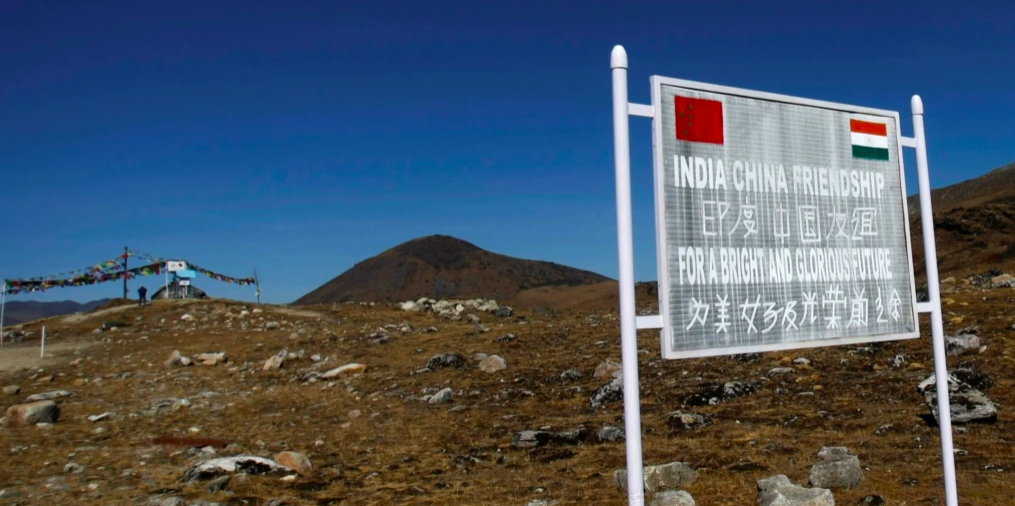China’s new domestic land border legislation has somehow not garnered as much widespread attention in India as it should have. The law provides semblance to the disparate pieces of the jigsaw puzzle of the Chinese territorial expansion on its Himalayan border. Coming close on the heels of a protracted, 18 months long India-China military standoff in Ladakh (northernmost Indian territory), the Land Border Law is a statement in itself. It indicates that the era of bilateral mechanisms for resolving the India-China “boundary question” and international norms on cross-border collaboration is over. The Chinese will employ the same tactics on their Himalayan border as used in Hong Kong and maritime disputes – territorial aggression, “grey zone” activities, and justification of their “expansionism” by domestic law. The brinkmanship this is likely to create with India can lead to repercussions – militarily, diplomatically and in the economic sphere.
The Chinese government passed the new law on the protection and exploitation of land border areas on 23 October, to come into effect on 1 January 2022. Certain factors could have motivated the passage of this law – stability of Chinese hinterland bordering Central Asia with the Taliban takeover of Afghanistan and the concerns of spillover of refugees from Myanmar, for instance. However, China has a relatively stable land border frontier with land disputes with 12 out of 14 countries settled by the 2000s. In this context, the law looks eerily like it has been passed to justify the Chinese activities along the Line of Actual Control (LAC, the de facto border between India and China), from the Doklam incident in 2017 to the most recent incursions in Ladakh in early 2020.
While China seemingly has disputes with everyone around it, four of China’s disputes have always been essential to its territorial integrity claims – Hong Kong, Taiwan, Tibet and LAC with India. With Tibet and Hong Kong under the belt, a recent Pentagon annual report substantiates that China is preparing for a two-front war scenario – border escalations with India and escalating military threat against Taiwan.
The provisions of the land border law seem to give legal cover to the Chinese “grey zone” activities along the Himalayan border with India. In simple terms, defined by the Australian 2020 Defence Strategic update, grey zone activities (articulated in the context of China’s maritime disputes) are sequential, gradually increasing escalations meant to check the opponent’s tipping point. In the India-China context, four law provisions seem to justify China’s attempts to “change the reality on the ground”.
- State support for constructing or upgrading border villages – This provision sanctifies repeated Chinese incursions along the LAC and attempts to build villages and create infrastructure. For example, there have been reports of the creation of a 100-home civilian village inside disputed territory between Tibet and Arunachal Pradesh (AP) by the US Department of Defence.
- Creation of “mass defence groups” in border villages, which emphasizes the civil-military fusion strategy. Including the formation of a People’s Armed Police (PAP) along the Indian border – this clause is reminiscent of the “Little Blue Men” of the Chinese maritime militia operating in the South China Sea. With their paramilitary nature, these groups can give the Chinese military plausibility of denial for escalatory action across the LAC.
- Reference to Chinese sovereignty over the water resources of cross-border rivers has led experts to state that the Chinese weaponization of the Brahmaputra water will continue. This includes withholding hydrological data and unilateral construction of dams on upstream, impacting the downstream water flow management.
- To top it all, the law allows for the use of military force to settle disputes on the Chinese terms as they challenge the status quo with new assets on the ground, military build-up, and forward troop deployment on the LAC.
Over the years, China has effectively deployed “lawfare” – using (domestic) legal systems and institutions to achieve a political goal. China has used many ways of encroaching on territory – the salami strategy, grey zone activities and encroachment on areas across settled/unsettled borders. It has contrived new historical claims like the Nine-Dash Line narrative for the South and East China Sea. It has used “debt trap” diplomacy in Tajikistan and Sri Lanka, wherein it has made a country cede a key territory or infra asset in exchange for debt forgiveness. China has then proceeded in crucial cases to give a legal sanction to its aggression and expansion. Though not a classic case of territorial expansion, a successful employment of lawfare has been in Hong Kong. In Hong Kong, the National Security Law passed in 2020 has become the precursor of legalizing Chinese attempts to suppress democratic opposition, arrest activists and crush the pro-democracy movement.
Similarly, in the maritime waters, the Coast Guard Law has justified years of island-building / reclamation and military build-up. This law allows the use of lethal force by the Chinese People’s Liberation Army (Navy) on foreign ships in waters that are “disputed”, for example, around the islands of Spratly, Paracel and Scarborough Shoal. Similarly, the Maritime Traffic Safety Law requires foreign vessels that are allowed “innocent passage” under international law to inform and take permission from the Chinese authorities in the South China Sea.
Emboldened by a lack of coordinated international response and faced with Asian neighbours dependent on its economic eco-system and supply chains, Chinese domestic legislation has generally signalled that all bets for negotiations, consensus building and arbitration are over. Now the parallels with Land Border Law and Indo-China border dispute are emerging with consequences in three major domains:
1- Militarily and diplomatic: This time, the Chinese aggression has met with Indian armed resistance even though delayed. The initial phases of Chinese encroachment on key border areas in Ladakh in early 2020 coincided with the spread of Covid-19 and caught India by surprise. Since then, India has matched Chinese military deployments leading to the first deadly Chinese-Indian military clashes since 1975 in the Galwan valley. The event led to the death of 20 Indian soldiers while China refused to disclose its casualties. Since then, 18-rounds of Commander-level talks have borne no solution.
The new Land Border Law, which institutionalizes Chinese attempts at territorial revisionism in the Himalayas and India’s counter-resistance, is creating a geopolitical and military cauldron between the two Asian giants. Reports have indicated an “infrastructure war” along the Line of Actual Control, including building new air bases on the Chinese side and roads, bridges and tunnels along the Indian side. Unlike India’s border with Pakistan, the LAC has been comparatively stable since the 1980s, governed by many agreements and CBMs. However, with a race to infrastructure development and militarization, the creation of “civilian forces” and hyper-nationalism on both sides, accidental escalations will be difficult to control. As issues escalate on the border, the Chinese have been known to employ warfare in the technology realm – cyber attacks, hacking and espionage, for which India has an inadequate counter defence.
2- Reverberations of this geopolitical clash are being felt in the Indian sub-continent. The new law has raised concerns in Bhutan, which has seen increased Chinese border incursions in recent years – construction of villages, linking roads and military outposts. In Nepal, the law will likely support the Chinese attempts to challenge the boundaries deemed settled decades ago. However, more than exerting control over Nepal and Bhutan, Chinese efforts are a way to checkmate India. China has focused its aggression on territories that make India vulnerable – for e.g., the Doklam plateau (in Bhutan) close to the Siliguri corridor that connects India’s mainland to its north eastern part. As India-China one-upmanship increases in the region, interference in smaller countries’ can impact their political stability – as witnessed in Nepal with both countries supporting opposite camps.
3- The domestic economic impact of the situation is also more for India. Despite sincere though short-term efforts, the Indian supply chain in critical sectors (pharmaceuticals, renewable energy, rare earth minerals, automobiles, consumer durables) is still largely dependent on China. Despite souring diplomatic relations in the last year, the Indo-Chinese trade has grown by 49% to USD 90 billion, with over a 50% increase in Chinese exports to India.
Given the favorable balance of trade with India, China will not weaponize trade and finance against India as it did for the Japanese automobile companies during the East China Sea conflict (2011) or against Vietnam during a clash on disputed Paracel Islands (2014). However, it is on the Indian side that incidents such as the Galwan valley clash in 2020 or other attempts at Chinese incursions will force the government to take strict measures. As such incidents increase – sudden, reactive steps like import restrictions and banning Chinese components can impact the supply chain of crucial sectors. Given the uncertain nature of the Government of India (GOI) restrictions on merchandise and product trade with China, the Indian industry has not been consistent with supply chain diversification and remains vulnerable to sudden geopolitical maneuvers.
A key component where the GOI has started institutionalizing restrictions is on Chinese-backed FDI, including mandatory federal approval even for previously automatically approved sectors. From digital payments to e-commerce, gaming and other tech-related sectors have grown with investments from Chinese companies such as Alibaba and Tencent. With the global liquidity infused by large Covid-19 subsidies chasing the Indian market – many start-ups and companies are attempting to diversify their investment pool to reduce the impact of sudden policy changes. However, as of today, India remains unable to impose significant economic costs on China. This inability will both encourage Chinese expansionism against India and create risks of supply chain shocks and business impact as the GOI adjusts its response to a new Chinese era.
As Xi’s China turns Deng Xiaoping’s mantra “hide your strength, bide your time” on its head – all stakeholders need to be better prepared for a Chinese era of “show your strength, now is the time”.
Picture credits: Reuters / voanews.com
—This article was written in collaboration with Bipasha Bhardwaj. Bipasha is the co-founder and COO of Intelligentsia Risk Advisors, a strategy consulting firm that aims to facilitate “ease of doing business” by managing and mitigating geopolitical, social, operational and security risks. She has more than a decade of experience assisting clients in making informed business decisions by identifying risks and opportunities to ensure business operability.
Resource: https://asiapowerwatch.com/chinas-new-land-border-legislation-is-india-ready-for-chinese-lawfare/





